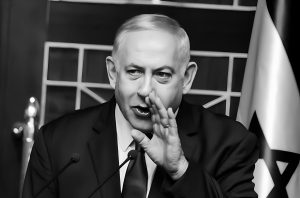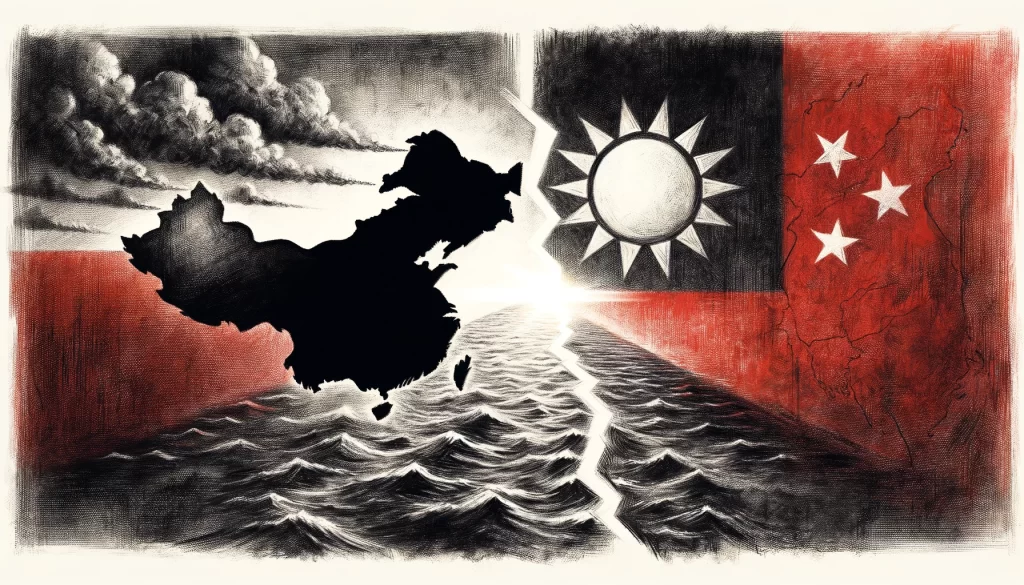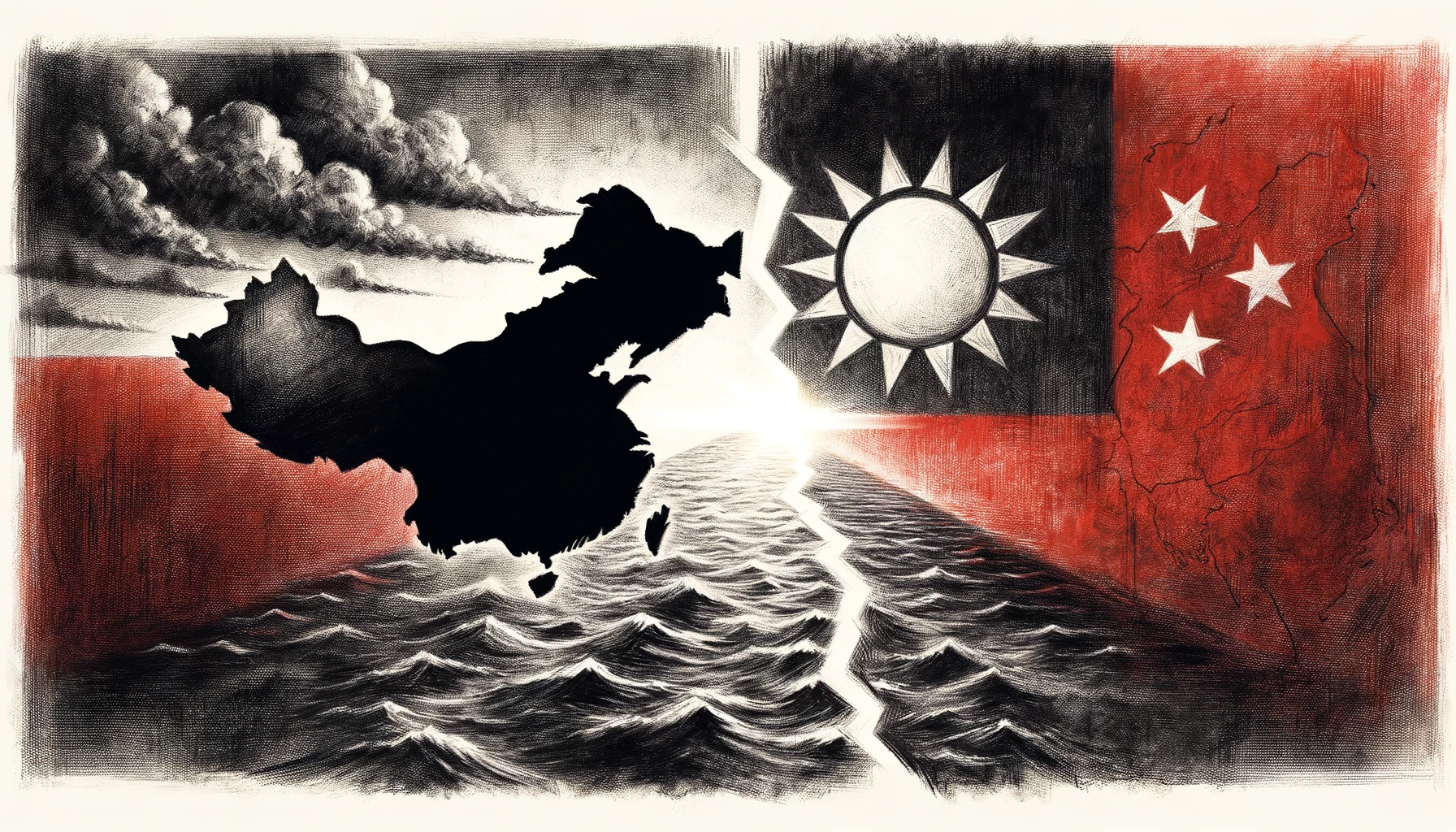
The latest incident in the Taiwan Strait illuminates the complex history of the region and the roots of ongoing tension between the two sides.
MARCH 19, 2024

On the afternoon of the fifth day of the Chinese Lunar New Year, February 14, 2024, a fishing boat from Fujian, China, entered the sea area of Beiding Island, southeast of Chin-men, and was chased by a Taiwan Coast Guard ship before capsizing. This incident caused tension in Cross-Strait relations and raised concerns in the international community about the dispute between the two sides of the Taiwan Strait. However, one question that may need further discussion and elaboration is why such an incident occurred near the offshore area of Fujian China, which is relatively far away from Taiwan and may impact the present Taiwan Strait situation.
The Taiwan issue, which has been repeatedly debated in international politics, originated from the Civil War between the Kuomintang and the Communist Party of China from 1945 to 1949 and the Korean War between 1950 and 1953. Till the end of 1949, the Communist Party of China (CCP) emerged victorious in the Civil War against the Kuomintang, and the CPP announced the establishment of the People’s Republic of China (PRC) on October 1, 1949. In December 1949, the leaders of the China (Kuomintang), Chiang Kai-shek and his followers, retreated to Formosa (Taiwan). At that time, the territory that the China still controlled included Taiwan and some outlying islands, such as the two islands (Chin-men and Ma-tsu Island) of the Fujian Province and the Dachen Islands of Zhejiang Province. The government of the China reopened the provincial government agencies in the name of Fujian and Zhejiang Provinces on the two islands of Chin-men and Dachen, respectively. In other words, at the end of 1949, according to the administrative division of Province Level in China, the territory of Actual Control of the Kuomintang and CCP overlapped in the two provinces of Fujian and Zhejiang. The CCP and the Kuomintang claimed sovereignty over China. However, Beijing did not control Taiwan and some outlying islands of Fujian and Zhejiang, and the Kuomintang army had just withdrawn from Mainland China.
When the Kuomintang government and the army had just retreated to Taiwan and those outlying islands in 1949, the U.S. government did not intend to be directly involved in the Chinese Civil War. However, Beijing and Moscow signed The Sino-Soviet Treaty of Friendship, Alliance, and Mutual Assistance in February 1950, and the outbreak of the Korean War on June 25, 1950, led to a change in the original stance of the U.S. government. On June 27, 1950, U.S. President Harry Truman made a speech to declare that, On behalf of the U.S. government, Truman ordered the U.S. Seventh Fleet into the Taiwan Strait in June 1950 to prevent Communist China from attacking Taiwan. Meanwhile, the U.S. military intervention also prevented the Kuomintang’s army from continuing to attack mainland China. According to the Formosa Resolution signed by U.S. President Dwight D. Eisenhower in January 1955, The U.S. government clearly stated that the U.S. military only promised to protect Formosa (Taiwan) and the Pescadores Islands (Penghu) against the armed attack by Communist China. However, the U.S. government has never promised to join military operations toward the Chin-men, Ma-tsu, and Dachen Islands
In the case of the U.S. government only promising to protect Taiwan and Penghu Island, why have Chiang Kai-shek and the Kuomintang still garrison the small offshore islands near Mainland China?
According to international law and related treaties, Taiwan was under Japanese colonial rule due to the 1895 Treaty of Shimonoseki signed between the Chinese Qing Dynasty and Japan, and later, the Qing Dynasty was replaced by the advent China in 1911. In the Cairo Conference of 1943, a declaration was released by the presidents of the UK, the US and China, stressing that ‘all the territories Japan has stolen from the Chinese, such as Manchuria, Formosa, and The Pescadores (Penghu), shall be restored China’. Based on this statement, After Japan surrendered at the end of the Second World War, China (Kuomintang) began to exercise jurisdiction over Taiwan in 1945.
As one of the founding members of the United Nations, the Republic of China (ROC) represented China in the United Nations (UN) since 1945 (until the ROC was replaced by PRC in 1971, according to The UN General Assembly Resolution 2758). Despite the defeat in the Chinese Civil War, Chiang Kai-shek, head of the Kuomintang, remained committed to reclaiming mainland China and believed that Taipei would be the temporary home of the Central government for the Republic of China. Therefore, the government of China should not abandon any land that is still within its sovereignty. Not only that, Chiang regarded those small islands close to the mainland as a forward base for the attempts of an all-out counteroffensive.
The military confrontation over Chin-men and Matsu between CCP and Kuomintang lasted until February 1991, when the National Unification Council, an advisory body of the government of the ROC government, formulated the Guidelines for National Unification. There is a view that this guideline marks the end of the strategy of the ROC government to “Retake the Mainland” by military forces and then Taiwan shifting towards a strategy of “Defensive Posture. Another opinion proposes that the civil war in China is not over yet after January 1, 1979 (when Beijing ordered the People’s Liberation Army to stop the bombardment of Chin-men and other islands), as both sides of the strait had never signed a ceasefire agreement, but its means and modes had changed. Either way, the semi-official representatives of the People’s Republic of China (PRC) in Mainland China led by the Communist Party of China and the Republic of China of Taiwan led by the Kuomintang met in Hong Kong (1992) to negotiate the meaning of ‘One-China’ and the solution to the Taiwan issue. As a result, the negotiation between the two sides reached certain understandings, which at least created a political foundation for semi-official cross-strait exchanges. (such as people-to-people and economic exchanges)
Following Taiwan’s Transition to Democracy in the 1990s, whether the CCP and Kuomintang reached an effective political consensus (i.e., the 1992 Consensus) during the semi-official meeting in Hong Kong has become a focal point in the elections. The main parties, Kuomingtang (KMT) and the Democratic Progressive Party (DPP), hold different views. KMT formulated its policy towards Mainland China based on the Guidelines for National Unification and admitted the existence of the 1992 Consensus. According to KMT, the content of the Consensus is ‘that the ROC and PRC “agree” that there is One China, and the Mainland and Taiwan areas are parts of Chinese territory, but they disagree (or ‘agree’ to disagree to a certain extent) about what “China” means (i.e., ROC vs. PRC). On the contrary, DPP rejected the existence of the so-called “1992 Consensus”, since it is a strategic political formula that implies Taiwan is part of China, which contradicts their ideological base of promoting Taiwanese nationalism and identity.
It is worth noting that CCP has never acknowledged Kuomintang’s narrative on the 1992 Consensus that Taiwan and some outlying islands have been under the title Republic of China. The ‘One China principle’ held by Beijing emphasizes that ‘there is only one sovereign state under the name China. Taiwan is an inalienable part of China, with the PRC serving as the sole legitimate government of that China’. According to this principle, both KMT and DPP’s stances on the political status of Taiwan are theoretically unacceptable. However, following the DPP winning the 2000 election for the first time in Taiwan, Beijing has been preparing to be relatively tolerant of KMT’s position since KMT will not pursue de facto Taiwan’s independence. For instance, CCP and KMT reached some cross-strait economic, political and people-to-people agreements from 2008 to 2016 when President Ma Ying-jeou’s KMT governed Taiwan.
After the DPP came back to power in 2016 and won the election in 2020 and 2024 again under the leadership of Tsai Ing-Wen and Lai Ching-te, respectively, Taiwan has bolstered its defenses against China over the past few years, including in the offshore islands of Chin-men and Ma-tsu. The shift in policy towards Beijing in Taiwan since 2016 bred the incident of a boat collision near Chin-men at the beginning of the article. In response, Beijing has gradually suspended all official contacts and some non-official contacts with the new government in Taiwan since 2016 to cease or limit the implementation of many cross-strait agreements. So far, the growing tension between Taipei and Beijing will likely be sustained. The historical evolution of cross-strait relations helps observers and readers interested in the issue understand and predict the future of the cross-strait relationship.
A curated seletion of FA’s must-read stories.
Written By: SHAGNIK BARMAN
Written By: BERK TUTTUP
Written By: ABBY L’BERT
Written By: BILLY AGWANDA
Written By: HIRA SARWAR
Written By: BATUHAN GUNES
Written By: LEON REED
Written By: DARSHAN GAJJAR

Li Shi-yu is a PhD candidate in Political Science and International Relations. His primary focus areas are regional initiatives in China's foreign policy, International Relations Theories, and the region of Central and Eastern Europe.
Written By: GABRIEL RAMIREZ
Written By: DILARA SAHIN
Written By: DILRUBA YILMAZ
Written By: NILAY CELIK
Written By: ELDANIZ GUSSEINOV
Written By: JOSEF SCHOEFL
Written By: SELCAN BEDIRHANOGLU
Written By: FATIH CEYLAN
FA’s flagship evening newsletter guilding you through the most important world streis ofthe day. Delivered weekdays.
